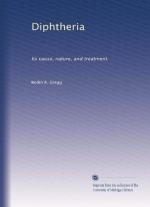|
This section contains 345 words (approx. 2 pages at 300 words per page) |
An acute bacterial infection characterized by the formation of a gray or yellowish-white membrane over the throat and nasal passages.
Diptheria can affect any of the body's mucus membranes, causing swelling of the neck and inflammation of the heart and nervous system, and certain strains can result in widespread organ damage. Diphtheria is also a possible cause of croup, an inflammation of the membranes lining the trachea, larynx, or bronchial tubes. The disease usually strikes children between the ages of one and 10. Symptoms include low-grade fever, headache, sore throat, general malaise, and, in some cases, swollen lymph nodes in the neck. Diphtheria is rare in Western industrialized nations, where most children are vaccinated against it. In the United States, diphtheria immunization is part of the DPT vaccine, which also protects against pertussis and tetanus. It is administered to children at the ages of two, four, and six months, again between 15 and 18 months, and one last time at age four to six. Adult booster shots are recommended every 10 years.
While there are few chances for a child to contract diphtheria in the United States, children who travel to other countries with their parents can still be exposed to the disease. It is highly contagious and can be spread by coughing, sneezing, talking, or through the expelled breath of an infected person. The bacteria that cause diphtheria, Corynebacterium diphtheriae, incubate for one to six days after exposure, after which symptoms gradually appear. The disease is treated with antibiotics and antitoxins. Although the risk of contagion is eliminated almost immediately following the beginning of treatment, full recovery takes longer, requiring bed rest and sometimes hospitalization. Diphtheria can be fatal, so prompt diagnosis and treatment are essential. When antitoxins are administered within three days of the onset of illness, full recovery is probable.
For Further Study
Books
Bennett, Claire L. Communicable Diseases Handbook. New York: Wiley, 1982.
Organizations
National Institute of Allergy and Infectious Diseases (NIAID)
Address: 9000 Rockville Pike
NIH Building 31, Room 7 A50
Bethesday, MD 20892-2520
Telephone: (301)496-5717
(Arm of the National Institutes of Health that deals with allergies and diseases.)
|
This section contains 345 words (approx. 2 pages at 300 words per page) |


